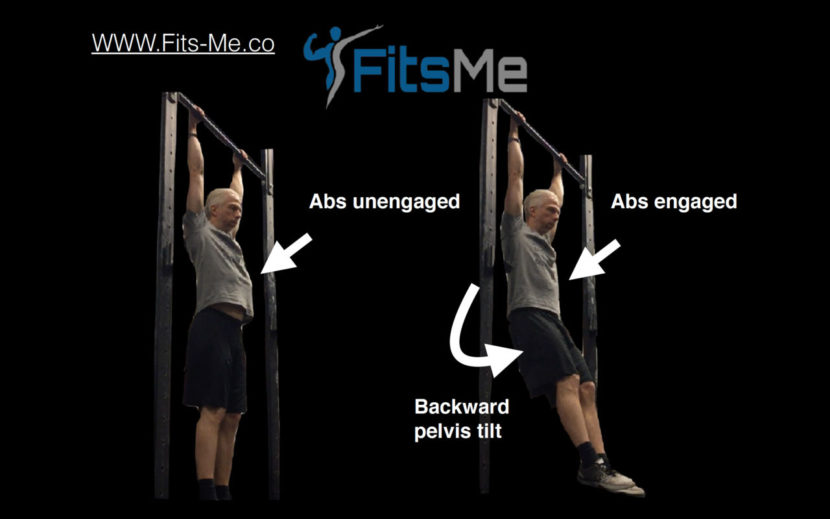Many years ago, the recommend way of working your abs was to do a lot of crunches – preferably hundreds every day 🙂
Then somebody found out that they weren’t that good as you could hurt your lower back if not done correctly. Also, the impact on the abs wasn’t that great. Basically most people were working their hip flexors and not their abs.
The new thing was then the plank: a great exercise that efficiently works the complete core. People started to see how long they could stay in the plank and for some it was hours.
Unfortunately, though the plank is a great exercise, it’s not just focusing on the abs but the complete core. Even worse, when done incorrectly, the abs then are engaged very little.
The question what exercise to do if you really want to focus on the abs.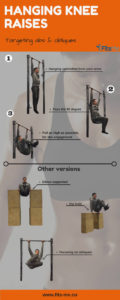
Here comes the drum roll… hanging knee raises. I’m saying that there aren’t other great bodyweight exercises that work the abs because there are (plank, L-sit, hollow hold etc) but if you really want to focus on your abs, hanging knee raises are one of the best exercises. At least when done right.
What do we talk about when we talk about abs?
We talk about the abdominal muscles (abs) or what we normally call a six-pack. Also, we will look a bit at the oblique muscles on the sides of our stomach.
What else will we look at in this article?
-
How to do hanging knee raises correctly
-
The key movement that makes them efficient
-
How to hit the muscles on the side – obliques
-
How many reps
-
How to make them harder
How to do hanging knee raises
For the first step, we have three options. All of them will work your abs equally well. Which one you select will depend on how strong you are in your arms. And of course, they will also strengthen your arms differently.
1. Hanging from sling straps. If your arms are very weak, this might be the best option as you then can focus fully on your abs. The downside is that you need to invest in a device with sling straps.
2. Hanging from a pull-up bar. In terms of equipment, this is the simplest version; all you need is a bar you can hang from. However, it will require some grip strength.
3. Hanging or rather holding your body off the ground in a dip station, parallel bars, rings or between some boxes/tables and chairs. This version can be done without investing in any equipment at all but you will need a good amount of strength to keep your body up.
Ok, from here, the exercise is the same no matter which of the three options you have chosen.
In a controlled motion without swinging, raise your knees towards your chest.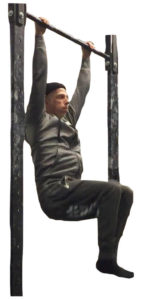
Make sure to tilt your pelvis at the top as this is where you really engage your abs – just raising your knees will work the hip flexors more than the abs. Therefore, make sure to raise the knees as high as possible. It’s not until your knees are above 90 degrees that the abs are really engaged.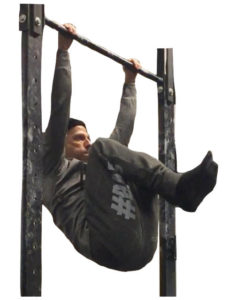
Again in a controlled motion, lower your knees a slowly as possible.
Repeat the motion.
Simple, right?
The key movement that makes them efficient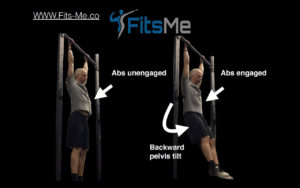
As mentioned, we need to tilt our pelvis at some point and that is where most people get things wrong. So study this movement carefully before you start to do a lot of reps.
Actually, you could isolate the movement to only the pelvis tilt but for most, it will be very hard. When we add the knee raise, we are in the middle of a motion and it’s easier to get the tilt.
If you think this sounds difficult then just make sure to really pull your knees to your chest, as that will make the pelvis tilt automatically.
How to hit the obliques
In order to hit the obliques as much as possible, we need to adjust the exercise a little bit. Here is how it goes.
A real hanging position is preferred. Therefore option 1 & 2 are better than option 3
Start the movement by flexing the hips and knees, drawing the legs up. Pull the knees up to one side, going above 90 degrees at the hip. Keep control and avoid any swinging.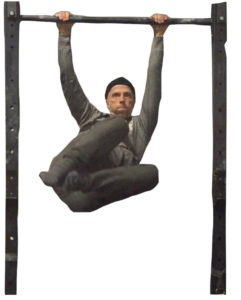
Repeat the exercise on the other side.
How many reps
This, of course, depends on how strong you are, however, a range of 5-15 repetitions for 3-5 sets is fine. When you can do more than that we need to modify a bit.
How to make them harder
At some point, you will be able to do more than 15 reps for 5 rounds and then we need to make them harder. We have several options.
-
Add weight – simply place some weights between your feet. A dumbbell, medicine ball or whatever will be fine.
-
Do them slower – slower means more time under tension. Count slowly when doing the movement and then just make them slower and slower.
-
Do leg raises – if we extend the legs, gravity will help us to work them harder. Make sure that the toes go all the way to the bar you’re gripping.
-
Holds – try to hold the top position for as long as possible. Meaning when your knees are closest to the chest, simply keep that position for as long as possible. Isometric holds are great for strength and especially for the core muscles.


